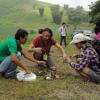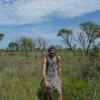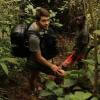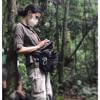Camera traps have been a key part of the conservation toolkit for decades. Remotely triggered video or still cameras allow researchers and managers to monitor cryptic species, survey populations, and support enforcement responses by documenting illegal activities. Increasingly, machine learning is being implemented to automate the processing of data generated by camera traps.
A recent study published showed that, despite being well-established and widely used tools in conservation, progress in the development of camera traps has plateaued since the emergence of the modern model in the mid-2000s, leaving users struggling with many of the same issues they faced a decade ago. That manufacturer ratings have not improved over time, despite technological advancements, demonstrates the need for a new generation of innovative conservation camera traps. Join this group and explore existing efforts, established needs, and what next-generation camera traps might look like - including the integration of AI for data processing through initiatives like Wildlife Insights and Wild Me.
Group Highlights:
Our past Tech Tutors seasons featured multiple episodes for experienced and new camera trappers. How Do I Repair My Camera Traps? featured WILDLABS members Laure Joanny, Alistair Stewart, and Rob Appleby and featured many troubleshooting and DIY resources for common issues.
For camera trap users looking to incorporate machine learning into the data analysis process, Sara Beery's How do I get started using machine learning for my camera traps? is an incredible resource discussing the user-friendly tool MegaDetector.
And for those who are new to camera trapping, Marcella Kelly's How do I choose the right camera trap(s) based on interests, goals, and species? will help you make important decisions based on factors like species, environment, power, durability, and more.
Finally, for an in-depth conversation on camera trap hardware and software, check out the Camera Traps Virtual Meetup featuring Sara Beery, Roland Kays, and Sam Seccombe.
And while you're here, be sure to stop by the camera trap community's collaborative troubleshooting data bank, where we're compiling common problems with the goal of creating a consistent place to exchange tips and tricks!
Header photo: Stephanie O'Donnell
No showcases have been added to this group yet.
- @stefan_istrate
- | he/him
Machine Learning Researcher & Nature Photographer. Building conservation tech for biodiversity monitoring at Wildlife Insights.


- 0 Resources
- 5 Discussions
- 9 Groups
Society for Conservation GIS


- 0 Resources
- 25 Discussions
- 5 Groups
NatureTech Product Manager
- 0 Resources
- 5 Discussions
- 1 Groups
GreenLab


- 0 Resources
- 20 Discussions
- 8 Groups
Luxembourg Institute of Science and Technology
Undertake and develop biodiversity monitoring


- 6 Resources
- 10 Discussions
- 4 Groups
My name is Caroline from Nairobi Kenya. I am a new entrant into wildlife conservation space and am looking forward to learning a lot more
- 0 Resources
- 2 Discussions
- 2 Groups
- 0 Resources
- 0 Discussions
- 5 Groups
Coordinator for Rewilding, Nature Recovery and Biodiversity Management at AJA Climate Solutions, Ghana.
- 0 Resources
- 0 Discussions
- 4 Groups
- @Rewildman
- | He/Him
Eco-entrepreneur. Concerned with the fundamental interconnectedness of all things creative and environmental.
- 0 Resources
- 2 Discussions
- 8 Groups
PhD student in animal biology working on AI for wildlife conservation

- 0 Resources
- 1 Discussions
- 7 Groups
- @srfreeze
- | He/Him
I am a wildlife expert with a decade of experience working with bats and proven success in efforts to study, manage, and conserve the species. I work at the nexus of advanced technologies and deep ecological understandings to provide effective solutions to government, academic, a
- 0 Resources
- 0 Discussions
- 11 Groups
We strive to shine a light on the achievements of bioacoustics research in Africa. We work towards equal representation and access to crucial learning, training, and networking opportunities in bioacoustics in Africa.
- 0 Resources
- 0 Discussions
- 7 Groups
Article
In 2019, the U.S. Navy initiated a time-lapse camera study to investigate seal presence at select haul-out locations in the lower Chesapeake Bay and coastal waters of Virginia, which are important areas to Navy training...
13 July 2023
Apply for funding (£500,000-£750,000) to develop software systems, which will help to improve biodiversity monitoring by automating the analysis of images and videos
12 July 2023
Applications are now open till 23 July for the 2023 Canon Oceania Grants with the category of the Environmental Grant valued at AU$5,000. The finalist will be selected based on the environmental and social merits of...
7 July 2023
Article
At Appsilon, we are always working to enable our users to get the most out of our solutions. With this in mind, we are happy to introduce two new add-ons to Mbaza AI.
4 July 2023
In this Conservation Tech Showcase case study from Osa Conservation, you’ll learn about how technology is aiding their long-term efforts to prevent wildlife crime, protect critical species, and build a climate-adaptive...
22 June 2023
In this interview between Rob Appleby and Ellie Warren, we discuss the importance of DIY, recycling, and sharing tools in order to make our community more sustainable.
14 June 2023
New insights into the behavior of the large-antlered muntjac, a critically endangered deer species in Southeast Asia, are revealed through camera-trapping, shedding light on scent marking as a communication method used...
12 June 2023
Careers
Permanent and Full Time role at the UK Centre for Ecology & Hydrology
8 June 2023
Acorn removal study of Nendo Dango, Ecological Restoration Research group at the University of Granada
5 June 2023
The saola, also known as the 'Asian unicorn,' remains one of the world's most elusive and rare animals. Conservation organizations, such as the Saola Working Group, operating in Laos and Vietnam, are conducting...
18 May 2023
Camera traps installed in Vietnam's Phong Dien Nature Reserve have yielded remarkable images of rare and endangered species, igniting optimism for biodiversity conservation in the region. Among the captivating...
18 May 2023
This article compares and contrasts the success of their wolf monitoring efforts with both collars and camera traps. The camera traps were intended to help researchers identify individual wolves within the population,...
5 May 2023
August 2025
event
event
September 2025
event
event
event
December 2023
event
November 2023
event
58 Products
Recently updated products
4 Products
Recently updated products
| Description | Activity | Replies | Groups | Updated |
|---|---|---|---|---|
| Hi Lucie @luciegallegos ,Great to see ecoSecrets and happy to collaborate in any way I can! All EcoAssist's models are open-source, and the inference code too. With regards to... |
+10
|
Software Development, AI for Conservation, Camera Traps | 6 months ago | |
| Another question. Right now pretty much all camera traps trigger on either PIR sensors or small AI models. Small AI models would tend to have a limitation that they would... |
|
AI for Conservation, Camera Traps, Data management and processing tools, Open Source Solutions, Software Development | 6 months ago | |
| Thanks so much!! |
+10
|
Camera Traps, Latin America Community | 6 months ago | |
| Some thoughts as I have experience working with some of the tech mentioned... Corrodible pin@htarold Did a great job explaining how that works. This pin is used in the pop-up... |
+10
|
Camera Traps | 6 months ago | |
| Hi, I'm collecting screenshots (and explanation if needed) of visualisations that you found useful. It could be charts, maps, tables... |
|
Data management and processing tools, Animal Movement, Camera Traps | 6 months ago | |
| I’ll reply with further commercial details direct to you. I think you are not supposed to discuss to that level in these discussions. This is managed product at this stage, not... |
|
Camera Traps | 6 months 1 week ago | |
| Hello, I am new to camera trapping and I have been researching trail cameras for a project to photograph the city. I need a trail cam... |
|
Camera Traps | 6 months 1 week ago | |
| Do the short videos happen mostly at night? If so, this is likely a problem with low batteries. The higher power required to power the IR flash can cause the camera to... |
|
Camera Traps | 6 months 2 weeks ago | |
| Hi, I am using these for my current project: They seem to be of good quality and support offline SD card storage. These run on 5V/1A. You should be able to run them for... |
|
Camera Traps, Animal Movement | 6 months 3 weeks ago | |
| Hi Simon,We (Reneco International Wildlife Consultants) have an ongoing collaboration with a local University (Abu Dhabi, UAE) for developing AI tools (cameratrap/drone... |
|
Acoustics, AI for Conservation, Animal Movement, Camera Traps, Citizen Science, Connectivity, Drones, Early Career, eDNA & Genomics, Marine Conservation, Protected Area Management Tools, Sensors | 6 months 4 weeks ago | |
| @HeinrichS there’s still time for you or anyone else to make a funding submission to the wildlabs 2025 grants ❤️❤️❤️I haven't applied for wildlabs funding, but I would love for... |
|
Human-Wildlife Coexistence, AI for Conservation, Camera Traps, Emerging Tech | 7 months ago | |
| A video speak a thousand words. I thought I’d share some fun observing the local wildlife in the back yard in thermal. |
|
Camera Traps | 7 months ago |
Introducing the WILDLABS On the Edge Fellows
10 February 2022 12:00am
Comparisons: Close-up Lenses for Camera Traps
9 January 2018 8:49am
14 January 2022 10:28pm
19 January 2022 11:29am
Wifi trail camera
3 December 2021 8:47pm
16 January 2022 11:41pm
This seems like an eminently sensible thing to try. The main issue I've seen with most wifi cameras is that their antennas are omnidirectional - i.e. they send in every (horizontal) direction, because they don't know where the other wifi endpoint is. That means their signal doesn't go very far, but it's easy to connect. The tplink (and ubiquiti) long range devices have very directional antennas, so their signal is very focussed in that direction, which effectively means it remains quite strong for some distance. They also have to listen for the (more-interesting) return signal though from the wifi camera, and that could cause you grief. However, the highly-directional antenna can pick up fainter signals, from the direction they are pointing at, so it may be ok.
Getting wifi (or any radio signal) over any distance depends a lot on circumstances (distances, terrain, vegetation, weather, interference, ...) so I can't generalise to say this would/wouldn't work. You'd have to try it and see (or get into wifi signal strength measurements and calculations, which you can do with some apps). Some cameras also have removable antennas, so you could replace an omnidirectional (stick) antenna with something much more directional. Or, set up a wifi bridge, with e.g. a ubiquiti point-to-point link, with one end is close to your wifi camera (to pick up its weaker signal) and the other end at the house.
There are plenty of wifi wildlife cameras on ebay, which I understood use their own wifi hotspot to learn how to connect to a broader wifi network - same as the reolink, etc. when you first set them up. Lacking a broader wifi network they might offer their own as a fallback, so you can download while walking by. But I've not tried them, as they are quite expensive, and I have little faith their wifi signal would reach far enough (as per above) for our needs. I'm trying to build my own wildlife cameras now, using esp32cam modules and an external wifi antenna, just waiting on a few more parts :-)
17 January 2022 1:23am
Markusb very true but those camera are not truly wifi, they are a wifi /Bluetooth camera , meaning the create there own wifi network to down load the pics you have to connect to that network.
Now in saying that I have not experimented in writing a code using a programming language to be able to turn on and off wifi or Bluetooth and then turn it back off and tell the code to be able to do this ever two hours or so.
But using a small form factor pc that is connect to a ubiquiti or tplink long range wifi device this is possible to a Bluetooth / wifi trail camera
17 January 2022 2:27am
Ok, understand. Note, the bluetooth feature is very short range, just to configure the camera from your phone when standing nearby. Wifi will give you some longer range and greater bandwidth for image/video downloads. If it is only offering its own wifi network then that is sad, but unsurprising (they try to be very simple/cheap). Doesn't change my point though about the signal strength - if you are trying to get a really long distance (which is "over 100m" on most wifi cameras) then you will need to add something in between. A dedicated NUC/RPi/small-PC would be one option - but your reolink already has a simple PC built in, that offers the remote control and download features and storage to an SD card, etc. You can write your code to talk to that, from your home, using the reolink API/CGI (https://support.reolink.com/hc/en-us/articles/900000625763-What-is-CGI-API). The small PC might still need to handle the "long-distance" wifi link if appropriate for your needs, in which case a ubiquiti/tplink wifi bridge (and a PC at home) might be more cost-effective? That can basically extend the camera's wifi back to your home.
This might need some whiteboarding and actual site-information to optimise :-)
Camera traps and community knowledge in Eastern India
20 December 2021 12:00am
Identification of Wildlife in Camera Trap Images
20 December 2021 12:00am
Feedback Needed: Wireless Camera Traps
4 October 2017 3:33am
16 November 2017 7:14pm
Just be aware of the limitations; you'll be transmitting at a very slow baud rate on frequencies that may have strict duty cycle (transmission time) and ERP (transmission power) limits. Check up on the rules for the region in which you intend to operate and make sure that the restrictions fit in with your intended application.
27 November 2017 5:03pm
The following two papers describe our attempst to develop an open source RPi camera trap platform with long range communications capability, and may be of interest:
Nazir, S., Fairhurst, G., Verdicchio, F., 2017. WiSE - a satellite-based system for remote monitoring. Int. J. Satell. Commun. Netw. 35, 201–214. https://doi.org/10.1002/sat.1176
Nazir, S., Newey, S., Irvine, R.J., Verdicchio, F., Davidson, P., Fairhurst, G., Wal, R. van der, 2017. WiseEye: Next Generation Expandable and Programmable Camera Trap Platform for Wildlife Research. PLoS One 12, e0169758. https://doi.org/10.1371/journal.pone.0169758
More details can be found here: https://erg.abdn.ac.uk/wise/
/Scott
7 December 2021 5:54pm
Vasudev
I have had no issues using ubiquiti device and pushing internet out to 5 miles line of site, what I am curious what are you using for you camera on the other end, I have always wanted to try and build a long distance wifi trail camera ( true wifi ).
is it solar powered or battery powered that has been my issue trying to figure out the power issue
Cellular and Lora camera traps
20 May 2021 10:51am
21 May 2021 8:36pm
Hi Antoine,
I am intrigued myself about how well a LoRa-based trail camera might work. I wonder if the 'LoRa' element is a more traditional radio connection? And of course the system still appears to rely on a cellular connection at the base station end. But interesting nonetheless.
On the radio side, there's also the CuddeLink model: https://www.cuddeback.com/cuddelink
However, I'd be sitting down when you look at the price.
I've had reasonable success with older model 3G cameras such as the Bolymedia MG983G-30M. From memory, it couldn't transfer video files larger than 10sec in length and it gets a bit glitchy if the batteries are running low. But, it worked well enough for me at the time.
If you do end up looking closer at the 'LoRa' model, please let us know how it works.
Cheers,
Rob
24 May 2021 4:09pm
Hi Antoine,
I had not seen these before, but I'll echo Rob in wondering if the radio links in these are truly what most would consider 'LoRa'. That tech/protocol generally has very low data transfer rates and would be quite challenged in sending pictures. That said, what they call it may not be relevant if it works for you. I would just be cautious of thinking it could integrate with other 'LoRa' devices or networks. Some other web sites that mention this system describe the radio link as 'proprietary'.
Kyler
7 December 2021 4:51pm
Antoineede they are a mesh style of camera, one links to the other and then send pictures back to the home unit where you either send them via cellular or you check the sd card. The cover Lora and cuddielink cameras do this but they play hell on battieries.
I had a cuddelink system and got rid of it , the home unit was to hook up to a pc and then from there you could easily wept a scrip to send to txt message or email etc but they scrapped that idea
Try our open-source automatic camera trap detection/labeling tool!
12 November 2021 8:31pm
1 December 2021 10:37am
This sounds so cool! I will try it out and spread the word.
6 December 2021 5:40pm
Wow, Zamba looks like a great tool. I'm curious about the terms of data use and privacy of the data uploaded to Zamba by users. I couldn't find that info on the website, could you point me in the right direction?
7 December 2021 3:55pm
Hi Morgan! We're currently still working out the exact terms. Are there any specific concerns that you had?
Low-cost underwater camera trapping and deep learning
30 November 2021 12:00am
Technical Difficulties: The Promise and Pitfalls of Machine Learning for Conservation
 Sara Beery
and 1 more
Sara Beery
and 1 more
23 November 2021 12:00am
Caiman: Images as Sources of Intelligence
18 November 2021 12:00am
Technical Difficulties: Pangolin in a Haystack
11 November 2021 12:00am
Opportunity: Wildlife Connectivity Technician (Seasonal)
3 November 2021 12:00am
Technical Difficulties: A Deployment Checklist
13 October 2021 12:00am
Technical Difficulties: Understanding the Realities
 Eric Becker
and 1 more
Eric Becker
and 1 more
13 October 2021 12:00am
Advice needed: Beginner's Conservation Tech Starter Kit
22 September 2021 6:06pm
5 October 2021 11:52pm
Hey Rob!
Thanks for all the tips! Getting 2 SD cards was a good reminder. I'd put extra batteries on my shopping list, but forgotten an extra SD card. Do you have a recommendation for a minimum SD card size?? I don't have any understanding of how long it'll take one of any size to completely fill up.
I also think I'll try a little of both for video vs. still images, but the majority of it will probably be video to see how the squirrels are behaving/fighting.
And I'm way ahead of you with the picnic table idea. These squirrels will be treated to some very fun props and dining opportunities along the way.
5 October 2021 11:56pm
Hey Harold, that'd be amazing! I'll get in touch for more info, thank you!
8 October 2021 1:02am
Hey Ellie--
Glad to see you getting started with this.
I'll speak to the data-storage question, it might be worth it for you to do something like paying for extra google drive space rather than go through the external hard drive process. That way you're ensuring you don't have to worry about losing your drive or just leaving it at home. It's $30 US for 200GB of space for a year, which is quite reasonable, especially for a single recorder / camera trap.
I'd also make sure you have an SD card reader, and maybe a sealed card holder/wallet to keep data safe while it transitions from the field. How much to budget for batteries will depend on exactly what sensors you end up purchasing but in my experience, ordering high-end alkaline batteries is the best bet (for example, in the Duracell line, their Procell D batteries really do perform better than the normal consumer level coppertop batteries). I'd recommend playing around with the scheduler software for whatever acoustic sensor you end up obtaining to figure out whether you'll be limited by power or storage depending on how you set things up.
Old camera traps go cellular
6 February 2020 12:00pm
27 August 2021 4:30pm
Oh very cool Robin. Do you mind if I ask how much it is for the unit?
27 August 2021 5:43pm
Hi Rob,
prices drop but I payed 88€ for mine.
7 September 2021 5:18pm
Thank Capreolus,
for your feedback, did you try it where the cellular network is weak?
Thank you.
How do I use animal-borne imaging technology in marine and terrestrial environments?
16 August 2021 12:00am
Workshop in analysis of camera trap data using distance sampling
7 August 2021 1:15pm
Tech Tutors: How do I use tech ethically?
5 August 2021 3:28pm
App Development Environment for Commercial Trail Cameras
1 July 2021 6:17pm
4 July 2021 12:27am
much appreesh @StephODonnell
21 July 2021 12:40am
I've put together a short slide deck outlining the concept and status (see attached PowerPoint). Critcally, I'm looking for a 1 to 3 "inaugural open source developers" to help launch the effort. Ideally, these developers would be associated with a project in need of enhanced firmware. I've already spoken with @Alasdair about this, and it looks like there could be an opportunity based on one of his projects. Please repond on this thread (or message me directly) if you know of anyone who might be interested or available. Skillset looks like:
•C (C++?) for Feature Development
•Python (for tool development)
•Thread-X RTOS
•Embedded System Software Design
•GitHub/Colab/Open Source Development Environments
•Ability to Operate (and to help define) a Nascent Software Development Environment
30 July 2021 2:18pm
@Freaklabs
Akiba may be interested?
How to dissociate the detector sensor from the camera in a camera trap surveyed area?
19 July 2021 8:36am
19 July 2021 7:11pm
I think it would be technically possible. Something like the camera being put to sleep, and only activated when an outer sensor is triggered. I would be more worried about getting ethical approval for such a study where the aim is to have a live domestic animal being attacked by a predator in a confined space.
20 July 2021 10:18am
Hi Egil, indeed, ehtcial approaval is of course needed and I will ask for it for sure! (But note that it is hard to explain farmers that I need ethcial approuval for that project aiming at reducing attacks, while they get attacks every other weeks despite fences, livestock guarding dogs and/or shepherds !!).
30 July 2021 12:29pm
My guess is that the camera triggering will prove to be far less of a challenge than getting ethical approval for penning livestock where predators can reach them. If you have such a high rate of wolf attacks in free-ranging flocks then you can directly measure the decrease in rate of attacks in flocks that have the repellent vs those that do not.
Tech Tutors: How do I get started with Wildlife Insights?
29 July 2021 12:04am
Wildlife Insights Launches
27 July 2021 12:00am
Time lapse camera: recommendations needed
20 May 2021 3:20pm
28 May 2021 6:40pm
Hi again,
DSLRs are not that complicated and they are also used in rainforests by photographers (for "nice" non-sccientific images). I have heard reports that termites can be rough though! I have seen people making heavy duty metal "overboxes" to protect against asian elephant "vandalism".
I have no experience myself with Reconyx ultra fire models and merely mentioned you might want to consider them as they have higher resolution and can thereby potentially record smaller details. With these small sensor cameras, as trail cameras are, the actually resolution is likely limited by the quality of the lens though!
With a DSLR you have a large sensor (= good quality pixels (less noise)), full control over the lens quality and angle of view BUT the setup will be considerably more expensive. I believe you could get comparable syncronisation of multiple cameras with either DSLRs or trailcameras.
18 June 2021 2:57pm
Hi Ivonne,
Have you considered using a GOPRO? They have some pretty natty features now and they have a good range of mounting and waterproofing gadgets. If you don’t need traditional camera trap features these work well and you can dial up the image quality to suit your needs.
Dave
22 July 2021 6:02pm
Do you need the photos during the timelapse, or just all at once at the end? If the latter, how many exposures will you need per timelapse recording? Depending on your answers, that might limit you to only options that let you retrieve images during recording - perhaps requiring wifi or celular?
Not knowing your requirements there, just some general thoughts:
GoPros
I too would think a GoPro would be an option, iff wide angle suits your purposes (though, if resolution isn't a high priority, GoPros do have exposure-time cropping options). Cheap, robust, with myriad accessories easily available. They also have wifi support - though, last I checked, you can't browse & download images while the GoPro is in recording mode (not even between exposures). Maybe newer models have removed that limitation?
There's also relatively novel options like the GoPro MAX with 360° video recording.
Trail cameras
I've used several different trail cameras that have timelapse options - they're pretty common. I haven't used Reconyx ones, though. In general I find trail cameras to be pretty useless photographically - fine, maybe, for just monitoring wildlife activity.
Mirrorless / DSLR
If you do go for a 'real' camera, go for one with (at least the option of) a pure electronic shutter. Few DSLRs have this option. Some - but not all - mirrorless do. Mechanical shutters (a) can cause motion blur and (b) tend to break after a few hundred thousand exposures. e.g. if you're doing one exposure per minute, you'd get less than a year from most consumer cameras.
The Sony a6100 (or later) cameras are good options for this - they're old and therefore can be found very cheap, but the image quality is still light-years ahead of trail cameras & GoPros.
A slightly more up-market option - probably only of any interest if night-time exposures are important - would be a Nikon Z5. Alas they're current-model so you probably won't find big discounts, but you get:
-
Excellent image quality (provided 24MP is sufficient resolution for you - are you aiming for 8K timelapse?). There are higher-end options (Z6, Z7) as well as Sony a7r options if you need higher resolution or (marginally) better image quality.
-
The ability to use practically any lense ever made on them (their Z mount supports adapters to practically any other mount system). In case you have particular lens requirements, or existing lenses you want to use.
-
Twin UHS-II SD card slots, so you can record to two cards simultaneously if data loss (from a faulty SD card) is a concern.
Keep in mind, though, that most mirrorless/DSLRs have limitations on how many exposures they'll allow on their built-in intervalometers (e.g. 9999 for Nikons). But there's usually ways around that using $10 plug-in intervalometers, if need be (and fancier options if you want more control, such as "bulb ramping" for recording across day & night smoothly).
24-hour monitoring of birds' nests
21 May 2021 1:43pm
17 July 2021 4:32am
Hi Ben,
This is relatively straightforward. It just requires an IP network camera, a 12V PoE injector, 12V power source, high-capacity SD card and an ethernet cable to your laptop.
I designed and put this ruggedized system together in a Pelican case for outdoor use. It may interest you:
https://envirocam.com.au
Various lenses from 2.8mm (wide-angle) to 16mm (close-up) can be used for or even thermal for complete visibility in darkness. Up to four lenses can record simultaneously for multiple angles of view.
Whist used for illegal-dumping detection in bushland, it can be equally used for your scenario.
I'm happy to give you some pointers - just reach out.
Best regards,
Anthony
21 July 2021 9:50pm
I would suggest, if time is of the essence, to use an off-the-shelf "security" camera.
I had some luck using Wyze cams, they are $35 apiece and connect via wifi. You power them via USB and it should be easy to set up either a large car battery with a usb charger or even a simple solar setup with a 5V output. The new version is weatherproof, although it would probably require further waterproofing for a rainforest setup. They are fairly small (I think something like a 5x5x5cm cube) and have visual motion detection, something that would be of benefit for your as it would also pick up reptiles as they move into the frame. They a microSD slot and you can view the data remotely, the app will send you notifications every time there is a movement detected. They are not in real-time but usually with less than a minute delay and for a couple of $$ a month you get unlimited cloud storage as well.
As mentioned earlier, of might be easier to run a camera on wire and power it with PoE, the connection would be much more stable but then you need to have a physical connection and a cable running through the forest which is another challenge.
Just my $0.02, keep in mind this is not as robust of a solution as, let say, envirocam, but it will allow you to set it up really quickly, given you have internet access.
22 July 2021 4:28pm
Dear Anthony and Michal,
Many thanks for the suggestions! Anthony, I have sent you a message through the site you linked to. I'd be interested to know more about the cameras you are using.
Michal, it's good to know about Wyze - I had not come across them. We're working with the options we have available in Brazil for now, but in future we may decide to import equipment. It's a long and bureacratic process to do so, even for relatively simple items. We don't have internet access at the field site, so it will have to be either a cable or local wifi setup (camera to computer). When we have a system set up I will try to post some details here about how it works out.
Thanks!
Ben
Tech Tutors: How do I get started with Megadetector?
22 July 2021 3:34pm
How do I get started with Wildlife Insights?
19 July 2021 12:00am
Structured light/lidar /laser for measuring animals in camera traps and BRUVs.
4 July 2021 10:41am
16 July 2021 2:35pm
Could you explain a bit more, do you want a measurement of length, or whole volume?
Like @wkcmark said, there are some simple solutions for measuring length fish, using stereo arrangements for example (2 cams looking at the same spot from slightly different angles). I also found this creative solution, using a single camera in a special acrylic case, that makes use of refraction indices. This, again, is for underwater systems.
If you could project two lasers at a known angle on the body of the animal like in exploration submarines, you could calculate the distance from the camera and measure the animal, although this would be a manual process.
17 July 2021 2:45pm
The simplest version might be a laser rangefinder, a measurement of image size, and some straightforward geometry, whihc would allow reasonable calculations of linear measurements.
17 July 2021 4:48pm
I've been wondering about rangefinding/size-measuring technologies that could be incorporated into camera traps for a long time, and am following this thread and the work of @Freaklabs with great interest.
So far I see there's stereo photography, Lidar, structured light/illumination, laser rangefinding, being suggested. I'm curious if we could come up with a relatively exhaustive list of potential technologies, then possibly discuss the pros/cons of each when used in a camera trap? For example, laser rangefinding might give precise and accurate measurements but maybe because it is an active sensor it drains the battery quickly and the laser might affect animals?
If there's interest I can start a separate thread so as to not detract from this one.
Tech Tutors: How do I choose the right camera trap(s) based on interests, goals, and species?
14 July 2021 8:42pm
16 July 2021 12:07pm
Thank you Stephanie,




































































14 January 2022 9:34pm